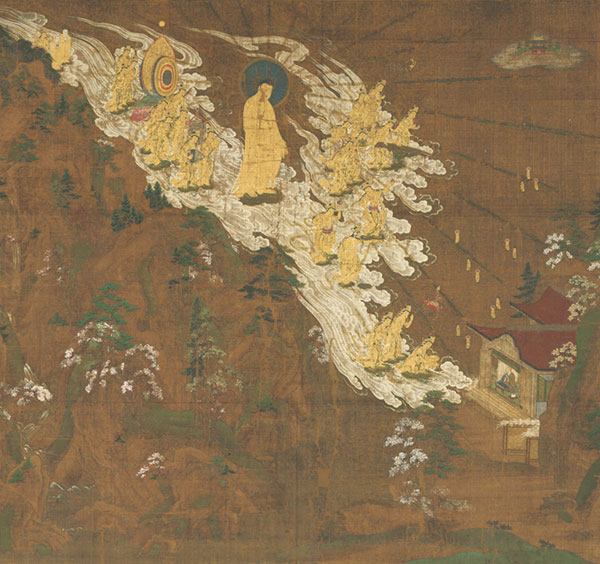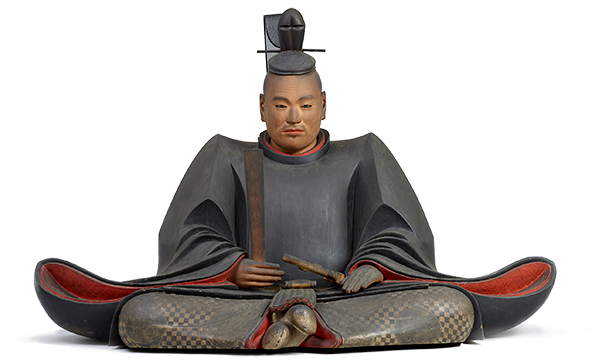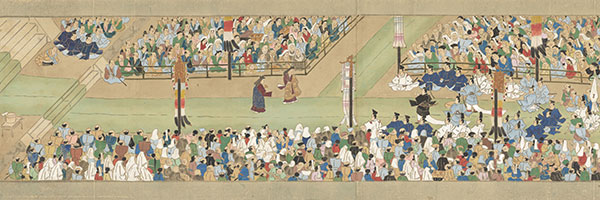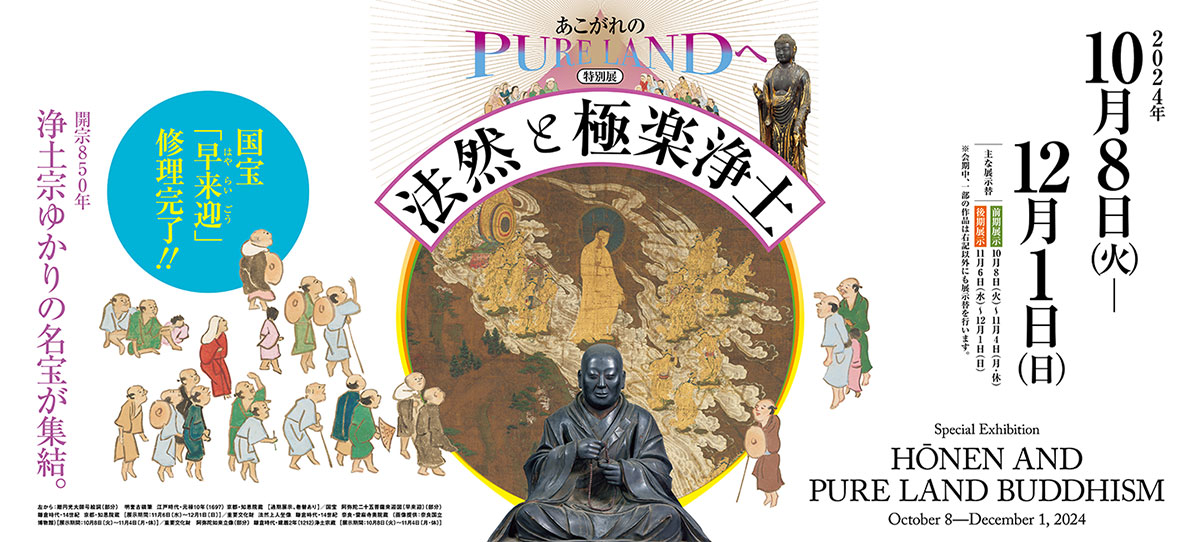- TOP
- Exhibitions
- Special Exhibitions
- Special Exhibition: Hōnen and Pure Land Buddhism
General Information
- Exhibition Title
-
Special Exhibition: Hōnen and Pure Land Buddhism
- Period
-
October 8–December 1, 2024
The exhibition has two installations:
Part I: October 8–November 4, 2024
Part II: November 6–December 1, 2024
Some artworks may be rotated during the exhibition period.
- Venue
-
Kyoto National Museum, Heisei Chishinkan Wing
- Closed
-
Mondays
*The museum will be open on Monday, October 14, and Monday, November 4, 2024; the museum will be closed Tuesday, October 15 and Tuesday, November 5, 2024.
- Special Exhibition Hours
-
9:00 a.m.–5:30 p.m. (Entrance until 5:00 p.m.)
Fridays, 9:00 a.m.–8:00 p.m. (Entrance until 7:30 p.m.)
- Special Exhibition Admission
-
Adult 1,800 yen
(1,600 yen)University Student 1,200 yen
(1,000 yen)High School Student 700 yen
(500 yen)- The discounted prices in parentheses ( ) are advance ticket and group ticket rates.
- Group ticket rates apply to groups of 20 people or more.
- Advance tickets will be on sale between August 20 and October 7 at major ticket outlets and other locations.
- See the official exhibition website (in Japanese only) for information about advance and discount advance tickets.
- Please show student ID for student admission.
- Admission is free for junior high school students and other youths age 0–15, visitors with disabilities and one caretaker. Please show ID.
- Admission is reduced by 500 yen for Campus Members (including faculty) able to produce ID.
- Audio Guide
-
Venue Rental Edition
- Fee
- 650 yen (includes tax)
- Duration
- approx. 35 min
- Languages
- Japanese, English
- Rental Hours
- 9:00 a.m.-5:00 p.m. (Return by 5:30 p.m.)
Fridays, 9:00 a.m.–7:30 p.m. (Return by 8:00 p.m.)
App Edition
- Fee
- 800 yen (includes tax)
- Languages
- Japanese
- Period of Availability
- April 16, 2024– November 30, 2025 (planned)
- Catalogue
-
For availability and purchasing information, see Exhibition Catalogues and Related Publications
- Organized by
-
Kyoto National Museum; NHK Kyoto Station; NHK Enterprises, Inc., Osaka Branch Office; The Yomiuri Shimbun
- With the special support of
-
Canon Inc.; Daiwa Securities Group; T&D Insurance Group; Meiji Holdings Co., Ltd.
- With the support of
-
East Japan Railway Company; Shimizu Corporation; Takenaka Corporation; Sumitomo Mitsui Banking Corporation; Mitsui Fudosan Co., Ltd.; Mitsubishi Gas Chemical Co., Inc.; Mitsubishi Estate Co., Ltd.; Mitsubishi Corporation
- With the special cooperation of
-
Jōdo Shū 850th Anniversary Celebration Committee, Agency for Cultural Affairs
- With the cooperation of
-
Nissha Co., Ltd.
- Special Exhibition Official Website
Description of Exhibition
The Japanese priest Hōnen (also known as Hōnen-bō Genkū, 1133–1212) was the founder of the Jōdo Shū, Japan’s first Pure Land school of Buddhism. He lived amid a turbulent era spanning from the end of the Heian period (794–1185) to the beginning of the Kamakura period (1185–1333). During this age of upheaval, Hōnen gained widespread support by advocating that anyone, regardless of their rank or circumstances in life, has the potential to attain salvation and be born into the Pure Land paradise of Amida (Amitābha) Buddha after death. Hōnen taught that the means of achieving this is to repeatedly chant the prayerful invocation Namu Amida Butsu (“I take refuge in Amitābha Buddha”), known as the nenbutsu.
This exhibition celebrates the 850th anniversary of the founding of Jōdo Shū through an exploration of the history of Japanese Pure Land Buddhism, beginning with Hōnen's founding of the school and extending through to the creation of various denominations by his disciples and the establishment of their respective doctrines. The exhibition also examines how Jōdo Shū grew and expanded significantly through the patronage of the Tokugawa shogunate during the Edo period (1615–1868). This historical journey will be traced through precious artworks, including numerous National Treasures and Important Cultural Properties associated with this school of Pure Land Buddhism.

National Treasure
Welcoming Descent of Amida (Amitābha) Buddha and Twenty-five Bodhisattvas
Known as Haya Raigō (the “Rapid Welcoming Descent”)
Chion-in Temple, Kyoto
[on view: November 6–December 1, 2024]
Section 1 Hōnen and His Time
Hōnen (1133–1212), the founder of the Pure Land Buddhist school Jōdo Shū, lived at the end of the Heian period (794–1185). This was a turbulent time marked by successive wars, frequent natural disasters, epidemics, and destitution. The widespread and continual anguish of the day convinced many that the world had entered an era called mappō, a degenerate age of the Later Dharma, when finding liberation through traditional Buddhism would no longer be viable.
Hōnen entered the priesthood at an early age and trained as a Tendai school monk on Mount Hiei, northeast of Kyoto, which was the center of Buddhism at the time. In 1175, at the age of forty-three, he awakened to the path of senju nenbutsu, the devoted recitation of Amida Buddha’s name, after encountering the writings of the Chinese Tang-dynasty scholar-monk Shandao (J: Zendō; 613–681).
Hōnen thereafter taught that simply reciting the nenbutsu—repeating the phrase, “Namu Amida Butsu” (I take refuge in Amitābha Buddha)—would lead to salvation. His teachings attracted a large following from all walks of life, but they also proved threatening to preexisting Buddhist sects, who forcefully demanded that the nenbutsu practice as interpreted by Hōnen be suppressed. Because of his popularity, they exiled Hōnen to Sanuki province (modern Kagawa prefecture in Shikoku) at the age of seventy-five. Eventually he returned to the capital of Kyoto, where he passed away at age eighty. This section traces the achievements and teachings of Hōnen, the founder of the Pure Land Buddhist sect Jōdo Shū.
![National Treasure. Illustrated Biography of Master Hōnen (Hōnen Shōnin e-den), Volume 6. Chion-in Temple, Kyoto [on view: November 6–December 1, 2024]](/jp/exhibitions/assets/special/honen_2024/honen_2024_026-06_1_3F-2.jpg)
National Treasure
Illustrated Biography of Master Hōnen (Hōnen Shōnin e-den), Volume 6
Chion-in Temple, Kyoto
[this scroll on view: October 8–20, 2024]
Section 2 The World of Amida Buddha
What Hōnen revered most was a devoted form of nenbutsu practice in which one focuses on reciting the phrase “Namu Amida Butsu,” which combines a personal commitment with the sacred name of the Buddha Amida (Skt: Amitābha). In contrast to earlier Japanese Buddhist sects, Hōnen taught that it was unnecessary to build lavish temples or commission Buddhist paintings or sculptures, since such acts often reflected economic or societal standing.
While Hōnen himself did not actively engage in the commissioning of Amida Buddha statues, he apparently accepted that some of his disciples and devotees considered the production of religious imagery to be essential. These practitioners venerated both sculptures of Amida Buddha and paintings depicting Amida’s “welcoming descent” (J: raigō) to receive the deceased and take them back to the Pure Land. Such adherents relied on visual icons for spiritual refuge during their daily nenbutsu practice and in the final hours of their lives.
Faith in the Pure Land tradition intensified among followers from all echelons of society during times of hardship. The many early statues and paintings of Amida that exist today testify to the popularity of the Pure Land school.
![Important Cultural Property. Standing Amida (Amitābha) Buddha. Jōdo Shū [on view: October 8–November 4, 2024]](/jp/exhibitions/assets/special/honen_2024/honen_2024_076-01_2_1F-1.jpg)
Important Cultural Property
Standing Amida (Amitābha) Buddha
Jōdo Shū
[on view: October 8–November 4, 2024]
![Important Cultural Property. Amida's Western Paradise and Hell. Konkai Kōmyō-ji Temple, Kyoto [on view: October 8–November 4, 2024]](/jp/exhibitions/assets/special/honen_2024/honen_2024_106_2_2F-5.jpg)
Important Cultural Property
Amida's Western Paradise and Hell
Konkai Kōmyō-ji Temple, Kyoto
[on view: October 8–November 4, 2024]
Section 3 Hōnen’s Disciples and Their Lineages
Surrounded by a growing number of disciples who revered him, Hōnen founded the Pure Land school of Buddhism Jōdo Shū. After his death, several of these disciples tirelessly worked to spread his teaching of shōmyō nenbutsu, a meditative vocalization of Amida Buddha’s sacred name. These disciples included Shōkō (1162–1238) of the Chinzei branch, based in Kyushu (previously known as Chinzei), and his disciple Ryōchū (1199–1287), who further expanded the group’s influence in Kamakura and other regions. In Kyoto, the Seizan branch, founded by Shōkū (also known as Seizan; 1177–1247), contributed greatly to the dissemination of Hōnen's teachings by producing painted reproductions of the Taima Mandala, a woven illustration of the Contemplation Sutra on the Buddha of Infinite Life (J: Kanmuryōjubutsu kyō).
![National Treasure. Taima Mandala. Taima-dera Temple, Nara. Photo courtesy of Nara National Museum. [on view: November 12–December 1, 2024]](/jp/exhibitions/assets/special/honen_2024/honen_2024_112_3_2F-2.jpg)
National Treasure
Taima Mandala
Taima-dera Temple, Nara
Photo courtesy of Nara National Museum
[on view: November 12–December 1, 2024]
![Important Cultural Property. Taima Mandala. Eikan-dō Zenrin-ji Temple, Kyoto [on view: October 8–November 10, 2024]](/jp/exhibitions/assets/special/honen_2024/honen_2024_114_3_2F-2.jpg)
Important Cultural Property
Taima Mandala
Eikan-dō Zenrin-ji Temple, Kyoto
[on view: October 8–November 10, 2024]
Section 4 The Pure Land Sect in The Edo Period
Building on an organized transmission of Hōnen’s teachings, the Jōdo Shū was further systematized by two later priests, Shōgei (1341–1420) and his disciple Shōsō (1366–1440). The latter was the founder of Zōjō-ji, the main Jōdo Shū temple in Edo (present-day Tokyo). Their efforts resulted in the
widespread dissemination of teachings of the Jōdo sect throughout Japan.
Such developments were further enhanced when the influential Matsudaira clan of Mikawa province (now southern Aichi prefecture) converted to Jōdo Shū. Later, Tokugawa Ieyasu (1543–1616), the founding shogun of the Edo-based Tokugawa military government and a descendant of the Matsudaira clan, designated Zōjō-ji in Edo and Chion-in in Kyoto as his ancestral temples, further solidifying the Jōdo Shū’s status.
This section explores the dramatic rise of Jōdo Shū during the Edo period through a diverse range of imposing treasures donated to Pure Land temples, attesting to the deep faith of their many shogunal and daimyo patrons.

Important Cultural Property
Seated Portrait of Tokugawa Hidetada
By Kōyū
Chion-in Temple, Kyoto

Imperial Presentation of the Posthumous Name
"Great Master Enkō" to Master Hōnen
(Zō Enkō Daishi gō ekotoba), Volume 2
By Myōyo Kokan
Chion-in Temple, Kyoto
[this scroll on view: November 12–December 1, 2024]







